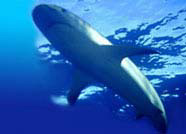


Shark Glossary

 |
 |
 |
|||
| Home | Evolution
| Classification
| Glossary | Biology
| Behavior | Shark
Repellent | Shark
Conservation | Do's &
Don'ts | Did You Know?
Shark Glossary |
 |
||||
|
Tapetum lucidum
The tapetum lucidum is a mirror-like reflecting layer within a shark's eye (behind the retina). It amplifies light (using platelets of guanine crystals) and allows sharks to see very well in dim light.  Teeth TeethSharks may have hundreds of teeth at one time. These teeth are modified placoid scales that have the same structure as a tooth, having an outer layer of enamel, dentine and a central pulp cavity. The shape of shark teeth varies from species to species. Thickskin Shark Carcharhinus plumbeus (also called the sandbar shark, brown shark, the northern whaler, and the ground shark) is a common shark with a very tall dorsal fin. They have mouse-gray skin, with paler skin below; the head is wide and flat. They largest found was about 8 ft (2.4 m) long; on average, females are 6 ft (1.8 m) long and males are 3.2 ft (1 m) long. Sandbar sharks are found from very shallow waters to deep waters, generally staying on the bottom. They also frequent estuaries and harbors. Sandbar sharks have a growth rate of about 1.7 inches (43 mm) per year, a slow growth rate for sharks. The thick skin is used for leather. These strong swimmers migrate over 1550 miles (2500 km). Their diet is mostly fish, including menhaden, eels, other sharks, skates, squid, and also crustaceans. Females are mature at 16 years and give birth to 8-12 live young after a gestation period of 9-12 months. Pups are about 8.5 inches (22 cm) long at birth. Classification: Order Carcharhiniformes, Family Carcharhinidae (requiem sharks). Thompson's Shark Thompson's Shark, also known as the Birdbeak Dogfish Shark and the Shovelnosed Shark (Deania calcea) is a pale-gray, bottom-dwelling shark about 3-3.5 ft (80-90 cm) long. Males and females have different types of teeth.  Thresher
sharks Thresher
sharksThresher sharks are Lamniformes (or mackerel sharks) whose tail fin has a greatly elongated upper lobe. Like other mackerel sharks, they have an anal fin, 5 gill slits, 2 dorsal fins, no fin spines, mouth behind the eyes, no nictitating eyelids. They are very strong swimmers. Species include the Common Thresher (Alopias vulpinus), the Bigeye Thresher (Alopias superciliosus), and the Pelagic Thresher (alopias pelagicus). It is also called: blue thresher, green thresher, longtail shark, swiveltail, fox shark, and the sea fox. Tiger Shark Galeocerdo cuvier is a fierce predator about 10 feet (3 m) long. It is found worldwide in warm seas. Tongue A shark's tongue is called a basihyal. A basihyal is a small, thick, relatively immovable piece of cartilage that is found on the floor of the mouth of sharks and fishes. The basihyal seems to be useless for most sharks, except for the cookiecutter sharks, who use it to rip "flesh-cookies" out of their prey (Shirai and Nakaya, 1992).  Tope TopeGaleorhinus galeus is also known as the School Shark and Soupfin Shark. This common shark is gray on top and white underneath; it frequently swims in schools. This harmless shark has a slim body , a small second dorsal fin, and a large top lobe on its tail. The Soupfin shark is up to 6.5 ft (2 m) long and has a life span of over 50 years. It eats squid, octopus, and fish. The Soupfin lives in temperate waters almost worldwide and migrates long distances to cooler water for giving birth. The Soupfin shark reproduces via aplacental viviparity, having litters of up to 52 pups after a gestation period of one year. Pups are about 12-14 inches (30-35 cm) long at birth. Females are mature at 8-10 years and have a low reproductive rate. It is fished for its fins, meat and liver oil. Galeorhinus galeus was named by Linnaeus in 1758. Classification: Order Carcharhiniformes (ground sharks), Family Triakidae (houndsharks, topes, whiskery sharks). |
|
|||||||||||||
| Sitemap | Reach To Us | Jimtrade - Business Directory of India | ||||||||||||||